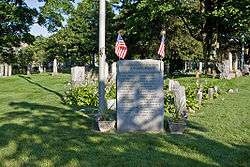Thomas Hanford
Thomas Hanford (July 22, 1621 – 1693) was a founding settler of Norwalk, Connecticut. He was the first minister in Norwalk, and continued in charge of the settlement's church for forty-one years, until his death in 1693. In addition to his spiritual leadership, he also served as the civic leader and school teacher of the settlement.[2]
Thomas Hanford | |
|---|---|
| Born | July 22, 1621 |
| Died | 1693 |
| Resting place | Plot 210, East Norwalk Historical Cemetery, Norwalk, Connecticut |
| Occupation | clergy |
| Spouse(s) | Eglin Hatherly
, Mary Miles Ince (m. October 22, 1661, New Haven Colony) |
| Children | Theophilus Hanford, Mary Hanford, Hannah Hanford Platt, Elizabeth Hanford Burr, Thomas Hanford, Jr. Eleazer Hanford, Elnathan Hanford, Samuel Hanford, Eunice Hanford Bulkley, Sarah Hanford Comstock[1] |
Early life and family
He was born in Fremington (near Barnstable), Devonshire, England, on July 22, 1621, the son of Theophilus Jeffrey Hanford and Eglin Hatherly.
Life in America
His mother, Eglin Hatherly Hanford, with Thomas' sisters, Margaret and Elizabeth, departed from London aboard the ship Planter on April 8, 1635. They arrived in Boston on June 7, 1635.
Thomas followed his mother at a later time in order to finish his studies in England. However, it appears that he did not finish in England, as he completed his studies in Massachusetts Bay Colony with Charles Chauncy, who later became the second president of Harvard University.
By 1643, he was in Scituate, Massachusetts, which was founded by his mother's brother, Timothy Hatherly.
He became a freeman of Massachusetts in 1650. In 1651 he went to Roxbury, Connecticut, to teach school. He taught for four months, but became discouraged by his students and quit in June 1652, citing ill health.[3][4]
Life in Norwalk
In 1652, Hanford, being "an orthodox and approved minister," was invited to join the settlement at Norwalk as the first minister of the First Congregational Church.[5][6] He was ordained in Hartford on May 18, 1654. The town gave him a lot of four acres, and built him a house. He was also given an island by a Winnipauk Indian named Sagamore, which today is called Sheffield Island.[6]
He is listed on the Founders Stone bearing the names of the founding settlers of Norwalk in the East Norwalk Historical Cemetery.
References
- History and Genealogy of the Families of Old Fairfield
- "Norwalk Historical Society - The Norwalk Town House, Part 1". www.norwalkhistoricalsociety.org. Retrieved 2016-04-18.
- Judd, Peter H. (2008-01-01). Four American Ancestries: White, Griggs, Cowles, Judd, Including Haring, Phelps, Denison, Clark, Foote, Coley, Haight, Ayers, and Related Families. Peter Haring Judd. ISBN 9781427637666.
- New Haven Town Records: General Court for New Haven, November 14, 1651, November 17, 1651, March 11, 1651/2, and June 7, 1652.
- Bouton, Nathaniel (1851-01-01). An Historical Discourse in Commemoration of the Two-hundredth Anniversary of the Settlement of Norwalk, Ct., in 1651: Delivered in the First Congregational Church in Norwalk, July 9, 1851. S.W. Benedict.
- The Ancient Historical Records of Norwalk, Connecticut: With a Plan of the Ancient Settlement, and of the Town in 1847. J. Mallory & Company. 1847-01-01.
